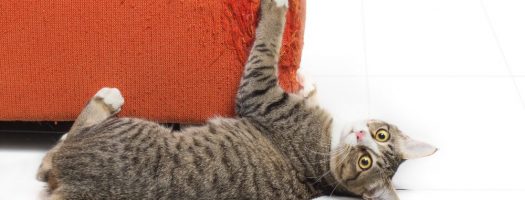The 10 Best Glucose Meters for Cats in 2025

Finding out that your feline friend is ill can be a stressful time and, unfortunately, cats are just as susceptible to disease and illness as their owners. Diabetes is a serious illness which means regular visits to the vet, which can be expensive. One way to decrease this need is by monitoring your cat’s condition at home. This means having access to, and being able to use, blood glucose meters.
These meters can range in costs from the price of takeout for a basic kit to thousands of dollars a year. By understanding the exact needs of your pet and the differences between available glucose meters for cats, you can save money and improve health for your furry pal.
- What You Need to Know About Glucose Meters for Cats
- Top 10 Best Glucose Meters for Cats 2025
- 1. Best Premium Glucose Meter for Cats: AlphaTRAK 2 Veterinary Blood Glucose Monitoring Meter Kit
- 2. Best Overall Glucose Meter for Cats: Advocate PetTest Blood Glucose Monitoring System
- 3. Best Calibration- and Coding-Free Pick: VetMate Blood Glucose Monitoring System
- 4. Includes a Lifetime Warranty: Auvon Blood Glucose Monitor
- 5. Best Budget Glucose Meter for Cats: Cera-Pet Blood Glucose Monitor
- 6. Most Helpful User Guide: iPet PRO Blood Glucose Monitoring System
- 7. Best from a Vet-Owned Company: Pet Control HQ Glucometer for Dogs & Cats
- 8. Easiest to Use: EverPaw Gluco HT111 Blood Glucose Diabetes Monitoring System
- 9. Most Affordable Blood Glucose Meter for Cats: GenUltimate!4Pets Meter Kit
- 10. Best for Healthy Cats: KIT4CAT CheckUp Kit at Home Wellness Test for Cats
- Guide to Buying the Best Blood Glucose Meters for Cats in 2025
- Frequently Asked Questions
- Final Thoughts
What You Need to Know About Glucose Meters for Cats
Before we dive into our list of the best glucose meters for cats on the market, let’s examine the most important things to be aware of before you choose one.
Do I Need a Glucose Meter for My Cat?
If you have a healthy cat, there is no need to own a blood glucose meter. You can still make sure their glucose levels are healthy, and you should learn the signs of if something is wrong, but you won’t need to subject them to the uncomfortable experience of daily tests.
How Do You Use a Glucose Meter?
Glucose level recordings all require a similar process. Pricking the animal’s paw, lip, or ear to draw a small drop of blood, putting that blood on a special testing strip, and then inserting that strip into an electronic meter which analyzes the blood. Each step is a factor that needs to be considered when choosing the correct blood glucose meter.
What to Look for in a Glucose Meter for Your Cat
To make sure you pick the right glucose meter for your and your cat’s needs, keep these important factors in mind.
How Accurate Is the Meter?
The FDA requires that a home glucose meter needs to be within 20% of a lab test result.
Cats with Type 2 Diabetes are less likely to require insulin, and tracking their blood glucose is less about specific numbers and more about trends. This means a high level of accuracy is less important when considering which meter to use.
However, if your cat is taking insulin and the results of testing inform the amount you give them, it is better to have the most accurate meters available. Simply being within the range required by the FDA might not be accurate enough.
Our top blood glucose meter, the AlphaTRAK 2, has a variance of only 5% and outperforms many high-end human meters.
How Complicated Is It to Use?
Complex meters have a learning curve, in which they need to be calibrated with control solutions, continually coded to testing strips, and used with special attention to contamination in order to obtain accurate results. Others are pre-calibrated and coded for ease of use. Some meters and strips have been specially designed to decrease contamination while others rely on the user alone.
How Reliable Are the Parts?
Feline diabetes is a long-term disease, and type 1 is incurable. This means you will be testing the blood glucose of your pet for years to come. Spending the money now on meters and lancing devices that are well-constructed, comfortable, and made of high-quality materials will save money in the long term. Fortunately, buying one brand’s meter does not mean you must always use their lancing device.
What Is It Going to Cost?
As much as we wish it didn’t, money matters. 50% of pets with diabetes are tested at least once a day. An owner deciding to go with the most expensive product will be looking at spending over sixty dollars a month on testing (that is, after the initial outlay). Other high-quality kits can monitor blood glucose at one-quarter of that price while still meeting the criteria for a good blood glucose meter.
Finding the right compromise between these four factors will help you find the blood glucose meter that is right for your cat. If you would like a more in-depth look at feline diabetes, how blood glucose monitoring works, and how to choose the best monitor for your cat’s health, check our full guide below.
Our list of the best cat glucose meters caters to every situation, and you are sure to find the perfect fit for your situation.
Top 10 Best Glucose Meters for Cats 2025
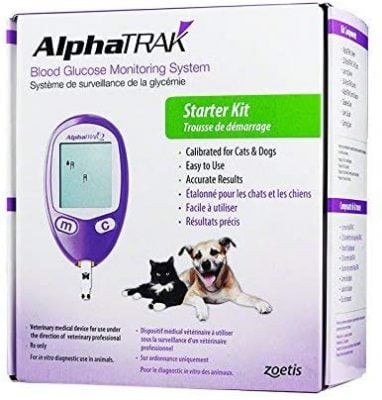
Editor’s Rating:
Why we like it: The gold standard in glucose meters, and used by veterinarians around the world, the AlphaTRAK 2 has the greatest accuracy using the smallest amount of blood. The kit comes with everything you need, including an instructional DVD and Diabetes Diary.
Price: $$$
Just the Facts:
- Kit includes: Meter, 25 test strips, lancing device and 30 lancets, control solution, user guide, carry case, and instructional DVD. CR2 battery included.
- Requires coding based on strips. Pre-calibrated for cats.
- Requires 0.3uL of blood.
- Stores 250 test results and offers 7 and 14-day averages.
Zoetis, Inc, is the largest manufacturer of livestock medication and vaccines in the world. The Zoetis AlphaTRAK 2 meter is so reliable and accurate that it has become the favored device of professional veterinarians. By choosing the AlphaTRAK 2, not only are you ensuring reliable measurements to help calibrate insulin dosages, you are receiving the same readings you would receive at your local vet. This means it is easier to notice long-term trends that can be reliably communicated to the professionals.
Only requiring 0.3uL of blood to function, there are fewer opportunities for errors in reading, and less necessity to re-prick the skin of the cat. While the device requires coding during every use and cannot be used with generic testing strips, this provides greater accuracy in readings. The kit is provided with a control solution; however, this is for peace of mind rather than any required calibration.
While the lancing device may be one of the more uncomfortable ones on the market, it is also the most effective. You do not need repeated attempts to draw blood. Lancets are of generic construction, and so less expensive ones are available.
It’s helpful that the AlphaTRAK 2 stores up to 250 test results, but this does include the occasional error, which throws off long-term averages. Fortunately, the kit also includes a diary for recording results.
The AlphaTRAK 2 is one of the most expensive meters available and the replacement strips can cost over a dollar a strip, making it the most costly choice over the long term. Diabetes is a life-long condition and with multiple tests needed a day, you could end up spending over a hundred dollars a month on top of the meter itself.
If you want the best available meter, there is no better alternative on the market.
Pros
- Most accurate readings on the market
- Used by your veterinarian.
- Requires only 0.3uL of blood.
- Records fewer errors than other meters.
Cons
- The most expensive long-term solution.
- Only holds a record of 250 tests, including errors.
2. Best Overall Glucose Meter for Cats: Advocate PetTest Blood Glucose Monitoring System
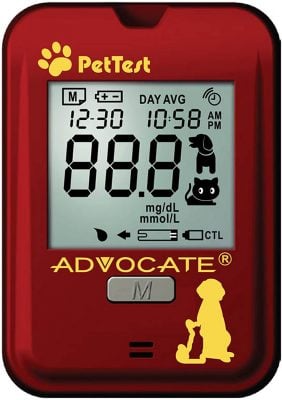
Editor’s Rating:
Why we like it: Almost as accurate as the AlphaTRAK 2, but at less than half the price, the Advocate PetTest has a larger memory, has a more comfortable lancing device, and does not require coding.
Price: $$
Just the Facts:
- Kit includes: Meter, 25 test strips, lancing device and 25 lancets, control solution, user guide, carry case, and instructional DVD. 2xAAA batteries included.
- Does not require coding. Pre-calibrated for cats.
- Requires 0.3uL of blood.
- Stores 400 test results and offers 7 and 14-day averages.
The Advocate PetTest may not be as accurate as its greatest competitor, but it is very close, with readings often only being 1 or 2 points off a veterinarian test. It does this despite not requiring coding at every testing and only taking 5 seconds to record a result.
The PetTest lancing device is the most comfortable of those tested and we would recommend purchasing it even if you choose another meter. Like the AlphaTRAK 2, it only requires 0.3uL of blood for reading and uses its own specific strips to increase accuracy.
The Advocate PetTest does have one minor issue. If any blood touches the strip, it will attempt to analyze the result. This leads to a larger number of errors as you practice using the meter and the very occasional inaccurate recording. Fortunately, the PetTest does not record errors in its 400 result memory and each strip costs half the price of the AlphaTRAK 2 strips.
Pros
- Almost as accurate as the AlphaTRAK 2, at half the price.
- Does not require coding or calibration.
- Requires only 0.3uL of blood.
- Best lancing device on the market.
- Larger memory
Cons
- Higher chance of errors and poor readings as you learn how to use it.
- Still requires its own specific strips.
3. Best Calibration- and Coding-Free Pick: VetMate Blood Glucose Monitoring System
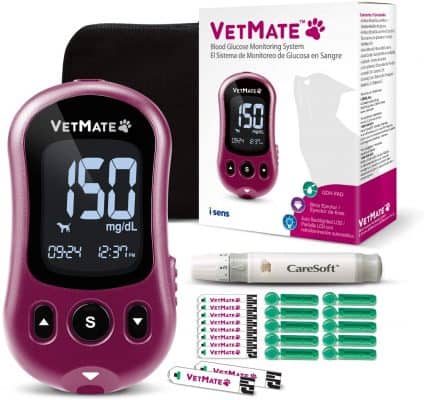
Editor’s Rating:
Why we like it: The VetMate Blood Glucose Monitoring System is a highly-accurate device that doesn’t require calibration or coding. Replacement strips are inexpensive and reliable and each test requires only a small amount of blood.
Price: $$$
Just the Facts:
- Kit includes: Meter, 10 test strips, lancing device and 10 lancets, user guide, carry case. 2xAAA batteries included.
- Does not require coding. Pre-calibrated for cats.
- Requires 0.4uL of blood.
- Stores 400 test results and offers a 14-day average.
iSens is a leader in human blood glucose testing and so it is no surprise that its “made-for-pets” monitoring system is one of the most accurate on the market and is used by some veterinarian practices. Coding is not required for the VetMate system and they market their lack of control solution as “not required, thanks to our highly accurate pre-calibration.”
The meter itself is comfortable to handle and the negative LCD screen makes it easy to read in bright sunlight. The lancing device, on the other hand, can sometimes fail to draw blood and is not as comfortable as the Advocate PetTest.
The VetMate requires little blood compared to most of the market, but not quite as little as the AlphaTRAK or Advocate systems. The VetMate can use generic strips without any coding required and is the only system in which this does not decrease the accuracy of readings.
The VetMate kit comes with just enough strips and lancets to see you through the first few days, and so your initial purchase will need to include refills of both immediately. Fortunately, these refills can be far less expensive than other brands and, in the long term, you end up saving money.
Pros
- No coding or calibration required.
- Accurate with small amounts of blood, even when using generic testing strips.
- Comfortable meter with an easy-to-read screen.
Cons
- Low-quality lancing device
- Higher initial cost than most systems.
4. Includes a Lifetime Warranty: Auvon Blood Glucose Monitor
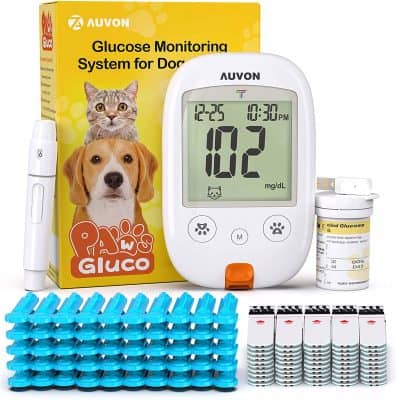
Editor’s Rating:
Why we like it: The Auvon Blood Glucose Monitor boasts all the Research and Development that goes into a human glucometer, but it’s calibrated for pets. It is also the only device that offers a lifetime warranty.
Price: $$$
Just the Facts:
- Kit includes: Meter, 50 test strips, lancing device and 50 lancets, code strip, user guide, carry case. 2x AAA batteries included. User guide videos given via URL.
- Requires coding. Precalibrated for cats and dogs.
- Requires 0.7uL of blood.
- Stores 500 test results with 7, 14 and 30-day averages.
Auvon makes some of the most popular glucose monitoring devices for humans, so it is natural that they would make a move into the pet market. In fact, the only difference between this monitor and one for humans is that this has been calibrated for cats and dogs. While requiring a higher amount of blood, it accurately produces a reading in under five seconds.
The lancing device is capable of doing the job and the lancets are generic, which means you can use less expensive ones easily. Auvon strips are close to half the price of the AlphaTRAK 2, and the starter kit contains twice as many strips as the Advocate PetTest. A great little addition to the device is a 4-alarm reminder system that doesn’t give you a heart attack when it goes off.
If a lifetime warranty and the reputation of a medical company offers extra peace of mind, this is the kit you want to buy.
Pros
- Fast and accurate readings.
- Created by a professional medical device company.
- Low-cost testing strips and generic lancets make long-term costs lower.
- Lifetime warranty.
Cons
- One of the more expensive devices on the market.
- Requires slightly more blood than other top-tier devices.
5. Best Budget Glucose Meter for Cats: Cera-Pet Blood Glucose Monitor
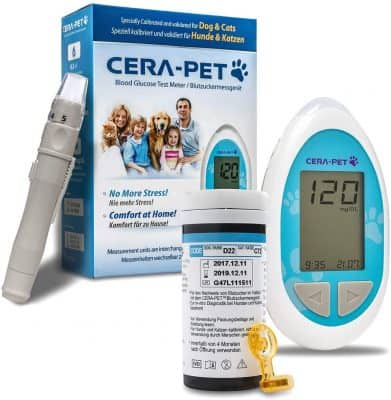
Editor’s Rating:
Why we like it: Less expensive than others without being low-quality, the Cera-Pet is one of the easiest meters to use, with specially designed strips and a comfortable lancing device.
Just the Facts:
- Kit includes: Meter, 25 test strips, lancing device and 25 lancets, 2x code keys, user guide, carry case. 1x 3V battery included.
- Requires coding from provided keys. Pre-calibrated for cats.
- Requires 0.5uL of blood.
- Stores 1000 test results.
While the Cera-Pet blood glucose meter is not as accurate as the AlphaTRAK 2 or VetMate products, it has been scientifically vetted by independent researchers. For the budget-conscious, this scientific backing assures cat owners that saving money isn’t risking the health of our pet. Very few products at this price range can say the same.
To increase the accuracy of the Cera-Pet monitor, the testing strips have been designed with holding guides that decrease the chance of contamination and errors. This is especially important because the meter itself is far more sensitive to contamination.
Surprisingly, the cost of Cera-Pet strips is still half that of other competitors.
The Cera-Pet lancing device is one of the best available, with five separate settings to help provide comfort to the pet while still drawing blood. The lancets themselves come with a clear casing on the head, to make it easier to see how far out the needles stick.
It’s hard to imagine that you can spend so little on a blood glucose meter and still receive a high-quality product. Cera-Pet does exactly that.
Pros
- Specially designed strips to avoid contamination.
- Lower price compared to similar quality devices.
- Lancing device has multiple comfort levels.
Cons
- Less accurate than higher-priced systems
- Meter is more sensitive to contamination.
6. Most Helpful User Guide: iPet PRO Blood Glucose Monitoring System

Editor’s Rating:
Why we like it: While a little more complicated to use than other systems, it is rare for the iPet PRO to give an error or widely inaccurate reading. This, combined with an easy-to-follow guide and well-designed meter, makes it a system worth considering.
Price: $$$
Just the Facts:
- Kit includes: Meter, 25 test strips, lancing device and 28 lancets, control solution, user guide, carry case. 2x AAA batteries included.
- Requires coding and calibration using the control solution.
- Requires 0.7uL of blood.
- Stores 500 test results with 7, 14, and 30-day averages.
The iPet PRO is not the most user-friendly system on the market. In fact, for ease of use, this kit would rank at the bottom of the list. However, if you are willing to learn, this may be the perfect blood glucose meter for you.
Learning to use the system isn’t difficult. A well-written user guide and multiple online videos help teach how to calibrate and code the meter and everything you need is provided in the one kit. Once set-up, the user interface is a delight to work with and the strips are not difficult to handle. Once past this stage, it is rare to deal with any errors and readings are as accurate as any other device.
The lancing device comes with multiple settings while the lancets are of generic design, which means long term savings. While the iPet PRO requires more blood than other high-end monitors, low amounts will simply not be recorded.
If you are willing to take the time to learn how to use the iPet PRO, the long-term benefits of low-error rates and higher accuracy will make it all worthwhile.
Pros
- Very low rate of errors
- Good lancing device and generic lances.
- Best user-guides available.
Cons
- Far more work to set up and calibrate.
- Moderately expensive.
7. Best from a Vet-Owned Company: Pet Control HQ Glucometer for Dogs & Cats

Editor’s Rating:
Why we like it: From a company owned by vets, this is an accurate kit with everything required to start testing.
Price: $$$
Just the Facts:
- Kit includes: Meter, 50 test strips, lancing device and 50 lancets, 2x code strips, control solution, user guide, carry case, logbook. 1 CR2 battery included.
- Requires coding and calibration using the control solution.
- Requires 0.6uL of blood.
- Stores 450 test results.
Pet Control HQ is an Australian company, run by a family of veterinarians, rather than a tech company with little understanding of pets. Their products are purchased by law enforcement agencies and other government organizations for their animals. This sort of reputation is bolstered by extremely friendly customer service.
The blood glucose meter from Pet Control HQ is a very accurate device with a low rate of errors. Like the iPet PRO, it requires calibration and coding but requires slightly less blood to perform an accurate reading. The kit comes with twice as many strips and lancets as most other options.
The Pet Control glucometer does take longer than other devices to come to a result, but you will only ever need to do it once. If the strip is clean and there is enough blood, the results come out perfectly every time.
Where the Pet Control kit fails is in its lancing device. It’s a flimsy pen that often feels like it might break under too much pressure, and it is also difficult to gauge if the lancet has been inserted correctly. If buying this kit, we would recommend also purchasing the Advocate lancing device separately.
If a high level of accuracy is your primary concern, the Pet Control HQ glucometer is one of your best options.
Pros
- High accuracy in readings.
- Kit includes lots of strips and lancets.
- Great customer service.
- Made by vets.
Cons
- Flimsy lancing device.
- Takes slightly longer to receive results than other devices.
8. Easiest to Use: EverPaw Gluco HT111 Blood Glucose Diabetes Monitoring System
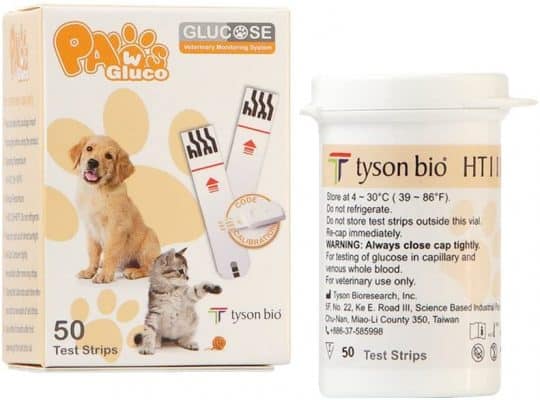
Editor’s Rating:
Why we like it: When you don’t need all the bells and whistles, the EverPaw system is perfect. It’s simple to use, inexpensive, and it has a handy strip-ejection system.
Price: $
Just the Facts:
- Kit includes: Meter, 50 test strips, lancing device and 60 lancets, coding strip, control solution, user guide, carry case, logbook. 2x AAA batteries included.
- Requires coding. Pre-calibrated for cats.
- Requires 0.7uL of blood.
- Stores 500 test results. 7, 14, and 30-day averages.
The EverPaw glucometer is a budget-friendly option that offers more than you might expect. Pre-calibrated, the coding strip only needs to be used once and then forgotten. It is one of the few devices that offer a strip-ejection button, making cleaning easier, and the kit offers more strips and lancets than more expensive options. The device isn’t complex to use, which means the poorly-written user guide isn’t as important as it would be in other kits.
The EverPaw system, however, will require patience. Not as accurate as other systems, it can sometimes present results that are unreliable, which means repeated testing. If there are issues with the device, customer service is neither fast nor helpful.
It has its issues, but for the price being asked, it cannot simply be ignored. If the purse strings are tight, this one purchase will give your pet what it needs for close to two months. Few other systems can say that.
Pros
- Everything you need for a low price.
- Easy to use.
Cons
- Not as accurate as other devices.
- Poor communication.
9. Most Affordable Blood Glucose Meter for Cats: GenUltimate!4Pets Meter Kit

Editor’s Rating:
Why we like it: The most affordable kit on the market, this is the ultimate “no-frills” choice.
Price: $
Just the Facts:
- Kit includes: Meter, 30 test strips, user guide, CR2 Battery NOT included.
- Does not require coding. Pre-calibrated for cats.
- Requires 0.7uL of blood.
At half the price of the next cheapest competitor, you have to give GenUltimate!4Pets a hand for taking “budget” to the next level. For less than a takeout lunch, you can have a blood glucose meter that does what it needs to do; no coding or calibration required. If you already have a lancing device and are looking for a back-up system (or one to keep in the car), this might be the option you are looking for.
As one might expect, the GenUltimate!4Pets is far from as accurate as other devices, but it is relatively consistent in its readings, which allows for the reading of trends. It requires no more blood than other low-tier devices and its replacement strips are very affordable.
Pros
- More affordable than two weeks of AlphaTRAK 2 strips.
- No coding or calibration required.
- Good to use as a back-up option
Cons
- Quite inaccurate.
- No lancing device or battery provided.
10. Best for Healthy Cats: KIT4CAT CheckUp Kit at Home Wellness Test for Cats
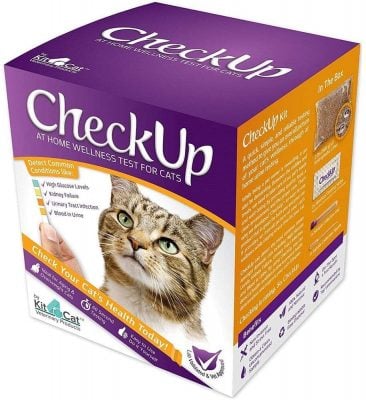
Editor’s Rating:
Why we like it: Not a glucose meter, but something completely different, the KIT4CAT CheckUp Kit is the perfect way to check your pet’s glucose without any invasive tests are expensive devices. What’s more, it checks for more than their glucose.
Price: $$
Just the Facts:
- Kit includes: Hydrophobic cat litter, 2 testing strips, a color-coded chart, and instructions.
- Results in 60 seconds, requires little preparation.
It’s reasonable to want to know about your cat’s health before it has a problem. Being pricked for a glucose test is uncomfortable. A diabetic cat cannot really avoid the practice. Now, though, a healthy cat can be given a preventative check without having to go through such an experience. While you could subject your healthy feline friends to the blood glucose meter, there are more comfortable ways to check if you should be concerned. The best of these is the KIT4CAT CheckUp Kit.
The kit contains two strips which test the cat’s urine. These strips can indicate when there is high glucose in the kidneys (which means it is very high in the blood) but also checks for urinary tract infections and signs that your pet’s kidney is struggling due to other disorders. The strips can only tell you when the blood glucose is sky-high, so the kit cannot replace blood glucose meters when managing an unhealthy cat. But as an early warning system, there is nothing better.
Pros
- Non-invasive
- Also checks for urinary tract infections and kidney failure.
Cons
- Is not accurate enough for managing feline diabetes.
Guide to Buying the Best Blood Glucose Meters for Cats in 2025
If you are looking at the best blood glucose meter for cats, it is likely that your cat has already been diagnosed with feline diabetes. Diabetes Mellitus is a condition in which the body does not produce or respond well to insulin, causing sugar to stay in their blood, rather than turn into fat. Since 2011, we have seen a 16% rise in diabetes diagnoses for cats in America, with cases of both type 1 and 2 diabetes being diagnosed every day.
Type I diabetes means that insulin is not being produced by the kidneys and will always include a need for insulin injections. Type II diabetes means that fat cells are ignoring insulin. While some cats with Type II require insulin, if the condition is discovered early it can be treated by diet alone. About 25% of cats with diabetes can avoid insulin injections.
Diabetes can cause trouble with a cat’s kidneys, eyes, and energy levels. Up to 1% of cats have diabetes, of which most have Type II.
What to Look for if Concerned About Feline Diabetes
The most common signs that your cat may have diabetes are:
- Drinking more often from the bowl, or drinking more each time.
- Urinating more frequently.
- Wanting to eat more despite gaining weight.
- Any major weight changes.
If you notice these things in your cat, visit the vet. The sooner diabetes is discovered, the sooner your pet can avoid complications. If you only have minor concerns, consider non-invasive glucose monitoring using the KIT4CAT CheckUp Kit.
More serious signs of diabetes include walking oddly with their hind legs, extra sleeping, and vomiting. If your cat has any of these signs, book a visit to your vet immediately.
When Accuracy Is Important in Monitoring Diabetes
A cat’s blood glucose level can normally be anywhere between 80-120mg/dl. When an “accurate” reading can be up to 20% away from the actual number, a cat with perfectly normal levels might read on the edge of too low OR too high. While this is not of major concern to a healthy cat, to a cat starting an insulin regime this could be dangerous. Receiving too much insulin can make a cat hypoglycemic (have too little blood glucose) and cause immediate problems like weakness, muscle seizures, and even unconsciousness. To avoid this, we need consistent and accurate readings. The most accurate blood glucose meter, backed by multiple scientific studies, is the AlphaTRAK 2.
The Problem of Contamination
Blood Glucose Meters are very sensitive devices that require as little as 0.3ul of blood to create a reading. That is 0.0003 milliliters! One drop of blood should be more than enough to get a good reading, so why do we get told that it sometimes isn’t enough? Why does a meter act like it can’t read the blood?
The answer is “contamination.” Contamination simply means that something other than blood is in contact with the sensor part of the testing strip. Dirt, sweat, cat hairs, even a fingerprint is enough to cause the sensitive machines to give an error (or worse, a bad reading!).
There are many ways to avoid contamination when testing the blood glucose of our cats, from washing our hands and the spot on the cat we will lance, to knowing the correct technique to put blood onto testing strips.
Some blood glucose meters are better than others at helping avoid contamination. Meters that do not need to be calibrated or coded regularly can save steps. Fewer steps, less chance of contamination. Some meters, like the Cera-Pet glucose monitor, have specially designed strips that are less likely to become contaminated.
How to Use a Blood Glucose Meter
While every blood glucose meter for cats is slightly different, especially in regard to using control solutions and coding, the main technique is the same for everybody. Below is a really good video by the American Animal Hospital Association:
If you are worried about your technique, do not hesitate to visit your vet. Not only can they help you learn how to use your device, but they can also compare its readings to their own, giving you peace of mind.
Frequently Asked Questions
In case you still have questions, we’ve answered the most commonly-asked ones below.
I’m Diabetic. Why Can’t I Just Use My Own Blood Glucose Meter?
Cats and humans both need the same amount of glucose in their blood to remain healthy (80-120mg/dl). However, while humans keep over 40% of their glucose in their red blood cells, cats keep almost all of theirs in the plasma. To get the most accurate readings, then, a blood glucose meter for cats must take into consideration where the glucose will be found.
Blood glucose meters for humans twice the amount of blood as the best meters for cats.
While the amount is small, the difference in comfort for your pet can be much larger. Finally, manufacturers of human blood glucose meters are not in communication with veterinarians, offering support and education on a regular basis. This is why vets use pet-specific devices, and why we should too.
If you have a human glucometer that you are really happy with, check if the company also makes ones designed for pets. Auvon’s blood glucose monitor, for example, was created on the back of their already existing human meters, redesigned and programmed to work for cats.
My Meter Saves Records, Should I Still Use a Logbook or Diary?
Yes. While many glucose meters record results, some of them up to 1000 results, none can export these results for printing or emailing. This means that someone wanting an overview of the last month’s results cannot do more than obtain an average. For a vet, what matters more than a monthly average or yesterday’s result is how the trend of results moving up and down looks like. The best way to do this is to look at a chart or table.
The American Animal Hospital Association provides printable diaries specifically for the monitoring of feline diabetes, while many of the glucose meter kits here come with their own logbook. Tech companies are starting to produce diabetic “tracking apps” for your smartphone. They automatically create graphs and detailed reports that can be emailed directly to your vet.
When Is the Best Time to Test My Cat?
The best times to perform a blood glucose test on your cat are first thing in the morning, before any injection, and late in the evening (two hours after their last meal). The most important thing is to always record at the same time of day, as that will give the best information to your vet.
Why Can’t I Draw Blood?
It is extremely unlikely that there is anything wrong with your cat, though some do have thicker skin than others. The most common reason why you can’t seem to draw blood is simply that you are too fearful of hurting them, and are therefore not applying enough pressure.
If you think you are being firm enough and are still failing to get that much-needed drop of blood, try the following things:
- Try different sites on your cat.
- Try a lancing device that has different settings and a clear end, so you can watch how far the lance is piercing the skin.
- Try using a lancet or needle without a device.
- Ask your vet for help!
Why Isn’t My Meter Working?
There can be a number of reasons why a blood glucose meter is giving either an error or a result that sounds too high or low to be true. As some glucose meters can be quite complicated, it can be difficult to work out what the real cause of the problem is.
Is There an Issue With the Testing Strip?
Testing strips have to be handled properly to work, that is, held by the sides so as not to become contaminated. If you have trouble with dropping strips or holding them the wrong way, consider using the Cera-Pet meter, which comes with specially designed strips that offer holding guides.
Testing strips also have use-by dates and may have specific code numbers that must match that used by the meter. Many meters rely on their own brand of strips and other brands will give errors.
Is There Enough Blood?
If there has not been enough blood placed on a testing strip, a meter may still attempt to give a reading, and it will be wrong. This is a common issue with the Advocate PetTest, as it begins recording the moment any blood touches the strip.
Has the Machine Been Calibrated and Coded Properly?
Not all blood glucose meters for cats are calibrated before being shipped. These require calibration before use, with a control solution that is usually provided in the kit. Over time, all machines will need recalibration.
Entering the wrong code, or using a code that does not match the strip, will also cause errors or poor recordings. Recalibrate and recode your machine before testing the next strip.
Is There an Issue With the Technique?
Using the wrong technique to place drawn blood on a strip is the most common cause of errors. Be sure to carefully read the user guide for your kit, and do a practice test in front of your vet. Some kits come with DVDs or video links, and we highly recommend generic tutorials from respected sources.
Is There a Fault With the Meter?
When every other box has been ticked, you have to assume that something has gone wrong with the electronic meter itself. What to do? Fortunately, the best blood glucose meters come with return policies including 30-day money-back guarantees and, in the case of the Auvon Blood Glucose Monitor, lifetime manufacturer’s warranties.
Final Thoughts
Discovering your cat has diabetes can be a stressful experience. Learning what you need to about diet, insulin and glucose can become overwhelming. Finding the right blood glucose meter for your cat can remove a lot of that worry. By knowing what to look for, and what each of the best meters offers, you can make a decision that saves money, helps your cat keep healthy, and keeps you from pulling your hair out.



